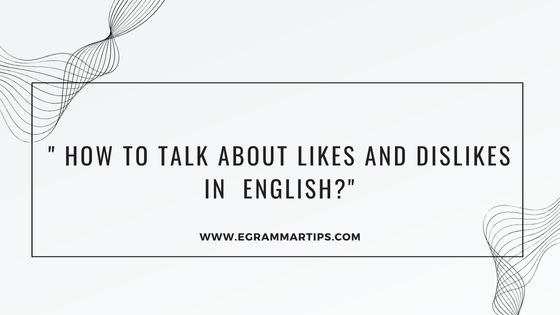
1. Introduction to Likes and Dislikes
Understanding and talking about likes and dislikes is a fundamental part of any language. In English, it’s essential to express your preferences clearly, as this helps build relationships, express your identity, and engage in conversations. Whether you’re discussing what food you prefer or your favorite hobbies, knowing how to communicate your likes and dislikes is crucial.
In this lesson, we’ll explore the vocabulary, grammar structures, and various expressions used to talk about likes and dislikes. You’ll also learn how to ask others about their preferences, respond effectively, and engage in deeper conversations about what you enjoy or dislike.
2.Vocabulary for Expressing Preferences
To express your likes and dislikes, it’s important to have a solid vocabulary. Here are some common verbs and adjectives you’ll use:
Verbs to Express Likes:
•Like: “I like ice cream.”
•Love: “She loves reading books.”
•Enjoy: “They enjoy playing soccer.”
•Prefer: “I prefer tea to coffee.”
Verbs to Express Dislikes:
•Dislike: “I dislike waking up early.”
•Hate: “He hates broccoli.”
•Can’t stand: “She can’t stand loud noises.”
•Detest: “They detest dishonesty.”
Adjectives for Emphasizing Preferences:
Favorite: “My favorite color is blue.”
Least favorite: “Math is my least favorite subject.”
Having these words at your fingertips allows you to articulate your preferences clearly.
3. Grammar Structures for Likes and Dislikes
When discussing likes and dislikes, certain grammar structures are commonly used:
Using “Like” and “Dislike” with Nouns:
“I like pizza.” / “I dislike spinach.”
Using “Like” and “Dislike” with Verbs:
“She likes to swim.” / “He dislikes running.”
Comparing Preferences:
“I prefer coffee to tea.”
“She prefers watching movies rather than reading books.”
Mastering these structures will help you express your preferences fluently.
4. Asking About Likes and Dislikes
To engage in a conversation about likes and dislikes, you need to know how to ask the right questions:
•Basic Questions:”Do you like pizza?”
•Polite Questions:”What do you prefer, tea or coffee?”
•Open-ended Questions:”What are your favorite activities on weekends?”
These questions will enable you to start and sustain conversations about preferences.
5. Responding to Questions About Preferences
When someone asks you about your likes and dislikes, your responses can be:
•Positive Responses:
“I love it!” / “I really like it.”
•Negative Responses:
“I don’t like it.” / “I hate it.”
•Neutral Responses:
“I’m okay with it.” / “It’s not bad.”
Being able to respond appropriately is key to effective communication.
6. Discussing Likes and Dislikes in Different Contexts
Preferences can vary depending on the context. Here’s how you might discuss them in different scenarios:
•Talking About Food Preferences:
“I love Italian food, especially pasta.”
•Discussing Hobbies and Interests:
“My favorite hobby is painting. I don’t enjoy hiking as much.”
•Preferences in Movies and Music:
“I prefer action movies to romantic comedies.”
•Preferences in Fashion and Style:
“I like wearing casual clothes, but I dislike formal wear.”
Each context may require specific vocabulary and expressions.
7. Expressions to Soften or Strengthen Preferences
Sometimes, you may want to express your preferences more subtly or strongly:
•Softening Expressions:
“I don’t really like spicy food.”
•Strengthening Expressions:
“I absolutely love traveling!”
Using these expressions will help you convey the intensity of your preferences more effectively.
We’ve explored how to express likes and dislikes using a variety of vocabulary and grammar structures. We’ve also discussed how to ask and respond to questions about preferences . I hope you enjoyed the lesson. Happy learning!
So insightful, please send me materials for on directions and talking about past events as well.
Thank you.
So insightful, please send me materials for directions and talking about past events as well. Thank you.